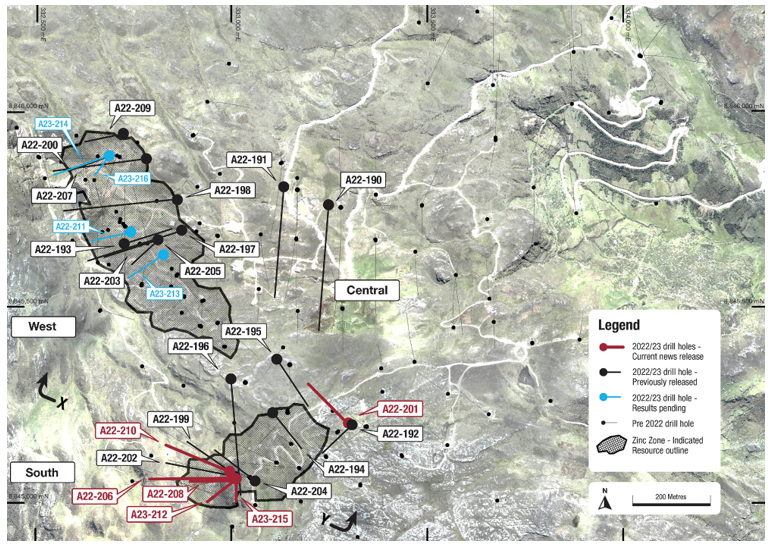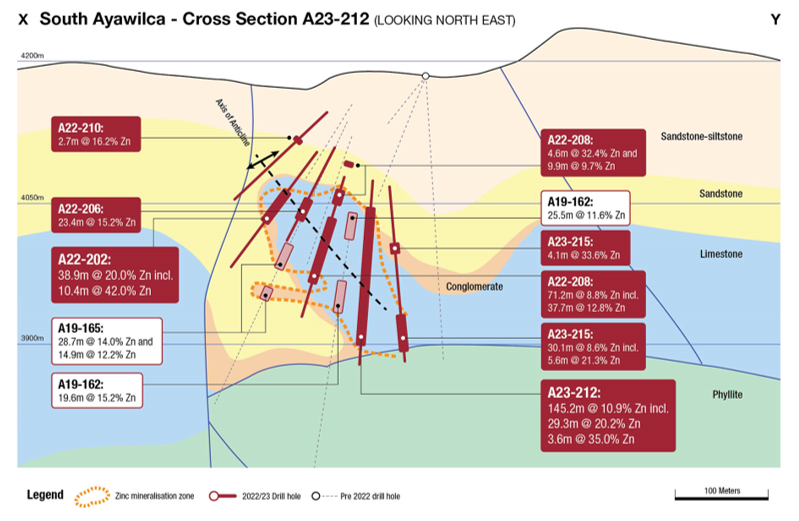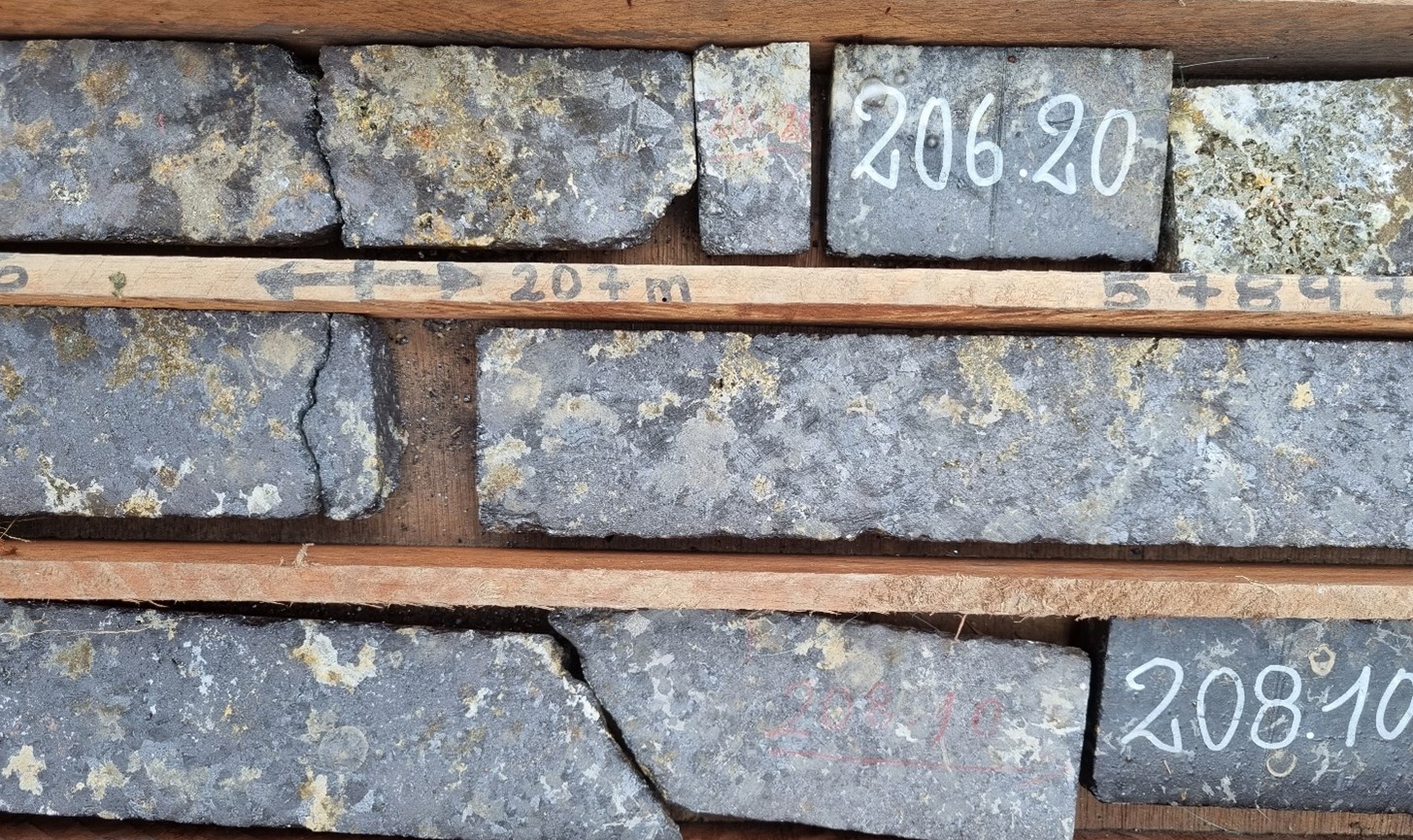par Tinka Resources Ltd. (NASDAQ:TKRFF)
Tinka Drills 145 Metres at 10.9% Zinc Including 29 Metres at 20% Zinc at Ayawilca
VANCOUVER, BC / ACCESSWIRE / March 6, 2023 / Tinka Resources Limited ("Tinka" or the "Company") (TSXV:TK)(BVL:TK)(OTCQB:TKRFF) is pleased to announce results for six recent drill holes from the Company's ongoing infill and resource expansion drill program at the Ayawilca project in Peru. All six drill holes are infill holes from the South Ayawilca area. Hole A23-212 returned much better than expected results with a thick and high-grade zinc intersection of 145.2 metres grading 10.9% zinc (estimated true thickness of ~ 100 metres) including 29.3 metres grading 20.2% zinc from a shallow depth of 158 metres. The drill program at South Ayawilca continues to exceed our expectations with respect to the continuity of the ultra high zinc grades. Drilling is expected to continue with two rigs until the end of April.
Key highlights of recent South Ayawilca drill holes
- Hole A23-212:
- 145.2 metres at 10.9% zinc from 158.2 metres depth, including:
- 29.3 metres at 20.2% zinc from 158.2 metres depth, and
- 10.6 metres at 14.9% zinc from 200.8 metres depth, and
- 9.8 metres at 15.1% zinc from 239.1 metres depth, and
- 3.6 metres at 35.0% zinc from 262.6 metres depth, and
- 25.8 metres at 13.1% zinc from 277.6 metres depth.
- The wide interval includes 4.4 metres of no recovery assumed zero grade in three separate zones.
- 145.2 metres at 10.9% zinc from 158.2 metres depth, including:
- Hole A22-208:
- 4.6 metres at 32.4% zinc from 105.2 metres depth; and
- 9.9 metres at 9.7% zinc from 142.1 metres depth; and
- 71.2 metres at 8.8% zinc from 168.8 metres depth, including:
- 37.7 metres at 12.8% zinc from 194.0 metres depth, including
- 2.7 metres at 45.2% zinc from 188.0 metres depth, and
- 20.0 metres at 16.9% zinc from 211.9 metres depth; and
- 37.7 metres at 12.8% zinc from 194.0 metres depth, including
- 1.7 metres at 36.3% zinc from 265.9 metres depth.
- Hole A22-206:
- 37.8 metres at 10.5% zinc from 153.5 metres depth, including:
- 23.4 metres at 15.2% zinc from 168.0 metres depth; and
- 2.7 metres at 45.2% zinc from 188.0 metres depth and 1.7 metres at 15.9% zinc from 200.3 metres.
- 37.8 metres at 10.5% zinc from 153.5 metres depth, including:
- Hole A23-215:
- 5.2 metres at 11.2% zinc from 144.4 metres depth; and
- 4.1 metres at 33.6% zinc from 190.0 metres depth; and
- 30.1 metres at 8.6% zinc from 263.4 metres depth, including
- 5.6 metres at 21.3% zinc from 264.5 metres depth.
- Hole A22-210: 2.7 metres at 16.2% zinc from 85.6 metres depth.
- Hole A22-201: An extension of hole A17-066 (extended by 59 m) did not intersect significant mineralization.
- A total of 10,000 metres have now been drilled for 30 drill holes in the 2022-23 drill program with a further 1,000 metres (approximately) to be completed. Seven holes have results pending.
True thicknesses of the mineralized intercepts are estimated to be at least 70% of the downhole thicknesses.
Dr. Graham Carman, Tinka's President and CEO, stated: "Hole A23-212 is without doubt Tinka's best ever hole at Ayawilca in terms of thickness and grade of the zinc mineralization - the hole intercepted a continuous zone of massive sulphide mineralization grading 11% zinc over an interpreted true thickness of approximately 100 metres. This hole is one of five fan holes reported here, following-up on the spectacular high-grade intercept of 39 metres grading 20% zinc including 10.4 metres at 42% zinc in hole A22-202 (link to news release). The results of these fan holes prove that there is excellent continuity of the high-grade zinc mineralization along a 200-metre strike length of folded limestone at the western extremity of the South Ayawilca deposit. This ultra high-grade zinc zone, which we are continuing to define and extend with more drilling, is expected to be very important for the project as it is located at the shallowest part of the South Ayawilca resource and therefore likely to be accessed early in the mine plan."
"Importantly, exploration opportunities still exist to expand this ultra high-grade mineralization. The drill program will continue until April with at least two more holes to be drilled at South Ayawilca. Several additional holes remain to be reported including five holes from West Ayawilca. Next steps for the project, following completion of the drill program, include an update of the mineral resource estimations and the evaluation of alternatives to fast track Ayawilca towards development."
Discussion of the geology
Table 1 summarises the highlighted drill intercepts for the six drill holes from South Ayawilca in this news release. The Company has now completed approximately 10,000 metres of drilling in 30 holes in the 2022-2023 resource definition-expansion program (see Table 2). A total of 23 holes have now been reported (see also previous releases Oct 11 2022 , Nov 21 2022 , Jan 9 2023 and Jan 24 2023. Table 2 summarises the complete list of holes drilled in the 2022-23 drill program. A drill hole map is presented in Figure 1.
This news release includes five holes drilled in a fan pattern from the same platform (holes A22-206, 208, 210, A23-212 and 215) targeting the core of an overturned fold ‘anticline' covering approximately 200 metres of strike length (north-south). An impermeable quartz sandstone, a unit of the local Goyllar formation, forms the footwall to the massive sulphide zone which has replaced the favourable Pucara limestone in the core of the anticline with substantial quantities of zinc. The sandstone is folded around the Pucara limestone forming an efficient trap which has concentrated the zinc mineralization in the hinge of the fold and along the contacts with the sandstone. High-grade zinc is associated with semi-massive sulphide (30-70% sulphides) to massive sulphide (70-100% sulphides) mineralization as sulphide replacements of the limestone and as veins into the sandstone. The sulphides are dominated by sphalerite, pyrite, and iron-rich carbonates (siderite) with minor magnetite, pyrrhotite, and quartz. Sphalerite (both high and low-iron varieties) typically comprises between 30% and 90% of the total sulphides.
An interpretation of the zinc mineralization in the recent drill holes is highlighted in Figure 2. The massive sulphide body dips at a moderate angle to the east. A major northeast-southwest trending fault located at the northern edge of the sulphide body truncates the mineralization to the north. This "060 Fault" (shown in Figure 2) could also be an important conduit for the mineralization at Ayawilca.
Figure 3 is an example of the ultra high-grade zinc cores from A23-212.
The final hole reported in this news release, A22-201, is a deepened exploration hole from 2017 (A17-077) to 430 m depth, targeting the possible extension of high-grade zinc mineralization intersected in nearby hole A22-195 (6m at 18.8% Zn from 392.6m depth) on the eastern side of South Ayawilca (see link). On this occasion, A22-201 did not intersect any significant mineralization possibly as a result of the thinning out of the manto structure in A22-195.
Table 1. Summary of drill hole results in this release from South Ayawilca
| Hole | From (m) | To (m) | Interval (m) | Zinc % | Lead % | Silver g/t | Indium ppm | Notes |
| A22-201 | no significant results | Extension of hole A17-066 | ||||||
| A22-206 | 153.55 | 191.35 | 37.80 | 10.54 | 0.06 | 17 | 181 | |
incl | 168.00 | 191.35 | 23.35 | 15.23 | 0.07 | 22 | 284 | |
incl | 188.00 | 190.65 | 2.65 | 45.21 | 0.14 | 76 | 1730 | |
| and | 200.30 | 202.00 | 1.70 | 15.92 | 0.02 | 9 | 187 | |
| A22-208 | 105.20 | 109.75 | 4.55 | 32.39 | 0.04 | 32 | 354 | |
| and | 125.40 | 127.25 | 1.85 | 17.33 | 0.04 | 15 | 87 | |
| and | 142.15 | 152.00 | 9.85 | 9.74 | 0.19 | 20 | 97 | |
| and | 168.80 | 240.00 | 71.20 | 8.75 | 0.51 | 33 | 55 | |
incl | 194.00 | 231.65 | 37.65 | 12.76 | 0.75 | 44 | 89 | |
incl | 211.70 | 231.65 | 19.95 | 16.92 | 0.01 | 6 | 87 | |
| and | 265.90 | 267.55 | 1.65 | 36.30 | 0.15 | 88 | 2940 | |
| A22-210 | 85.60 | 88.30 | 2.70 | 16.22 | 0.39 | 92 | 216 | |
| and | 157.20 | 164.20 | 7.00 | 4.39 | 0.45 | 79 | 4 | |
| A23-212 | 124.30 | 126.10 | 1.80 | 32.74 | 0.02 | 21 | 58 | |
| and | 158.20 | 303.40 | 145.20 | 10.86 | 0.19 | 31 | 229 | 1 |
incl | 158.20 | 187.45 | 29.25 | 20.17 | 0.04 | 21 | 418 | |
incl | 200.80 | 211.40 | 10.60 | 14.87 | 0.20 | 48 | 426 | 2 |
incl | 239.10 | 248.85 | 9.75 | 15.14 | 0.04 | 19 | 244 | |
incl | 262.60 | 266.20 | 3.60 | 34.96 | 0.07 | 50 | 868 | |
incl | 277.60 | 303.40 | 25.80 | 13.06 | 0.61 | 86 | 312 | 3 |
| A23-215 | 144.35 | 149.50 | 5.15 | 11.24 | 0.01 | 22 | 247 | |
incl | 144.35 | 145.45 | 1.10 | 31.46 | 0.03 | 32 | 811 | |
| and | 190.00 | 194.10 | 4.10 | 33.59 | 0.19 | 72 | 1263 | |
incl | 190.70 | 192.80 | 2.10 | 42.82 | 0.34 | 118 | 1629 | |
| and | 263.40 | 293.50 | 30.10 | 8.61 | 0.14 | 38 | 91 | |
incl | 264.50 | 270.10 | 5.60 | 21.34 | 0.06 | 36 | 451 | |
incl | 283.10 | 292.60 | 9.50 | 12.78 | 0.29 | 58 | 9 | |
1 | includes 4.4 m of no recovery assumed zero grade |
2 | includes 0.8 m of no recovery assumed zero grade |
3 | includes 3.6 m of no recovery assumed zero grade |
Figure 1. Drill hole map of Ayawilca highlighting drill holes released here in RED

Figure 2.

Figure 3. An example of high-grade zinc mineralization in hole A23-212. The interval 205.5 - 208.5 metres has an average grade of 31.3% zinc, 90 g/t silver, and 0.13% lead.

Note on sampling and assaying
Drill holes are diamond HQ size core holes with recoveries generally above 80% and often close to 100%. The drill core is marked up, logged, and photographed on site. The cores are cut in half at the Company's core storage facility, with half-cores stored as a future reference. Half-core was bagged on average over 1 to 2 metre composite intervals and sent to SGS laboratory in Lima for assay in batches. Standards and blanks were inserted by Tinka into each batch prior to departure from the core storage facilities. At the laboratory samples are dried, crushed to 100% passing 2mm, then 500 grams pulverized for multi-element analysis by ICPMS using multi-acid digestion. Samples assaying over 1% zinc, lead, or copper and over 100 g/t silver were re-assayed using precise ore-grade AAS techniques. Samples within massive sulphide zones were also assayed for tin using fusion and AAS finish.
The Qualified Person, Dr. Graham Carman, Tinka's President and CEO, and a Fellow of the Australasian Institute of Mining and Metallurgy, has reviewed and verified the technical contents of this release.
Readers are encouraged to read the NI 43-101 Technical Report entitled "Ayawilca Polymetallic Project, Central Peru, NI 43-101 Technical Report on Updated Preliminary Economic Assessment" available for download on Tinka's website at www.tinkaresources.com. The Technical Report was prepared by Mining Plus Peru S.A.C. ("Mining Plus") as principal consultant, Transmin Metallurgical Consultants ("Transmin"), Envis E.I.R.L ("Envis"), and SLR Consulting (Canada) Ltd ("SLR").
Table 2. Drill hole details for 2022-2023 drill program including drill collar coordinate information
| Drill hole | Easting | Northing | Elevation | Azimuth | Dip | Depth | Area | Comment |
| A22-190 | 333281 | 8845755 | 4167 | 180 | -50 | 498.95 | Central | Results reported |
| A22-191 | 333169 | 8845799 | 4182 | 180 | -55 | 478.80 | Central | Results reported |
| A22-192 | 333345 | 8845195 | 4208 | 232 | -74 | 385.90 | South | Results reported |
| A22-193 | 332766 | 8845659 | 4237 | 68 | -65 | 365.40 | West | Results reported |
| A22-194 | 333143 | 8845231 | 4226 | 135 | -73 | 380.20 | South | Results reported |
| A22-195 | 333149 | 8845353 | 4221 | 148 | -65 | 426.90 | South | Results reported |
| A22-196 | 333035 | 8845307 | 4235 |

